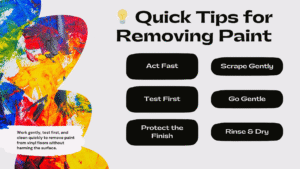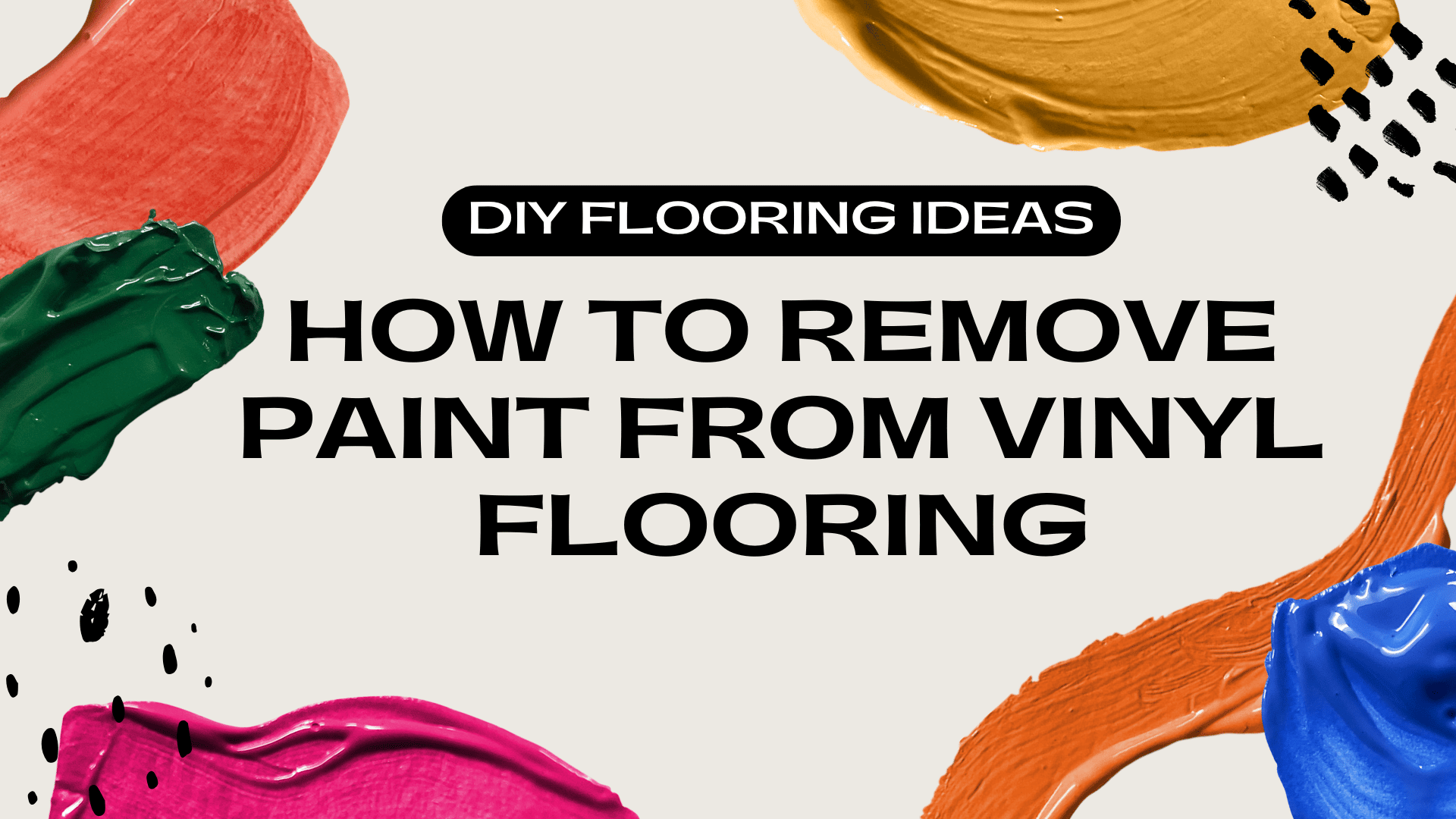Oops! Spilled paint on your vinyl floor? Don’t panic – vinyl is a durable, wipeable surface, and with the right approach you can clean it up without damage. Whether it’s vinyl plank, luxury vinyl tile, or vinyl with a wood-grain finish, the tricks are the same. The key is to work quickly for fresh spills and be gentle with dried paint. We’ll walk you through step-by-step methods for latex (water-based) paints as well as tougher oil-based paints. We’ll also share simple tools to use (and avoid), plus handy safety tips. Let’s save your floor!
Identify Your Paint Type
First, figure out what kind of paint you spilled. Water-based paints (like latex or acrylic wall paint) are usually easier to remove because they dissolve in water. Oil-based paints, spray paints, and specialty paints (like epoxy) stick on harder and need stronger cleaners. In general:
- Water-based (latex/acrylic) – Can clean up with soap, water or rubbing alcohol.
- Oil-based (enamel, spray paint, epoxy) – May need solvents (acetone, mineral spirits) or even professional help.
Knowing this will guide your cleanup steps. (For example, vinegar and soapy water work great on latex, but paint thinner is needed for stubborn enamel.
Act Fast on Wet Paint
Oh man, if that paint’s still wet, you gotta move fast—seriously, don’t wait around. Just grab a soft cloth or even a paper towel (whatever’s in reach, honestly) and blot the spot. Don’t start scrubbing like a wild animal because you’ll just smear it deeper. Once you’ve soaked up as much as you can, mix up some mild dish soap with warm water. Nothing fancy. Dampen a cloth or sponge, then gently wipe or pat the area. This trick works wonders on fresh latex or water-based paint and won’t mess up your vinyl. Once you’ve conquered the paint, rinse off any leftover soap with clean water and dry it off with a towel. Nine times outta ten, that’s all you need to make the mess disappear.
How to Get Dried Paint Off Vinyl Floor?
For dried paint, the process takes a bit more effort. Start by gently scraping off any crusty bits with a plastic scraper, spatula, or even an old credit cardt. Vinyl floors can scratch easily, so never use metal tools or steel wool – always use plastic or wood to avoid gouges. Once you’ve lifted away as much paint as possible, it’s time to dissolve the rest.
- Water-based (latex/acrylic) paint: Got some dried latex paint messing up your vinyl? Don’t panic, this isn’t a crime scene. Just grab some rubbing alcohol or straight-up white vinegar—yeah, the same kind you splash on fries if you’re feeling wild. Soak a rag or a cotton ball with your weapon of choice, slap it on the crusty paint, and let it chill for a few minutes. The paint should start to loosen up (vinegar’s acidity does the heavy lifting here, and it won’t ruin your vinyl either). After it’s had its little spa moment, rub or gently scrape at the spot—no need to Hulk out. If the paint’s extra stubborn, just repeat the process. Both these household legends do a decent job breaking down latex, but hey, maybe try it on a hidden bit first, just in case your vinyl’s got trust issues.
- Oil-based paint is a pain, right? Dried-up, it turns into this stubborn little monster. Here’s what I’d do: grab some acetone (yeah, the stuff in nail polish remover) or mineral spirits—just make sure they’re safe for vinyl. Dampen a rag with a bit of your chosen chemical and slap it right on the paint spot. Give it 10, maybe 15 minutes. That paint should start to loosen up, kind of melt a little. Then, just scrape or wipe it off—gently, unless you’re into the whole “scratched floor” look. Might have to go a couple rounds with it.
One thing, though—those solvents are strong as heck. They can mess with your vinyl’s color if you go overboard. Always, and I mean always, test on some spot nobody sees first. Don’t soak the floor, either—it’s not a pool party.
When you’re done, clean up with some warm soapy water so you’re not leaving any of that chemical gunk behind. And boom, good as new… or at least, not covered in old paint blobs..
If a particular paint stain refuses to budge, keep patient. Sometimes a second round of solvent and gentle scraping is needed. But remember: start with the gentlest method (soap/water, alcohol) and only move to stronger solvents if necessary.
Alternative Home Methods
Aside from soap, alcohol and acetone, some simple DIY tricks can help:
- Baking soda paste – Grab some baking soda and splash in a bit of water—just enough to make it all pasty, not soupy. Slap that stuff onto the dried paint, let it chill for a bit (think, go scroll TikTok, come back in a few). That gritty little paste is magic—it’ll help loosen the paint, but won’t mess up your vinyl. Take a soft sponge or even an old tee (honestly, whatever’s nearby), and rub it gently. Wipe it off, and boom, you’re done. Simple, cheap, and you’re not poisoning the planet.
- White vinegar solution – For water-based stains, mix equal parts white vinegar and warm water. Soak a cloth in this solution, wring it out, and wipe the paint stain. Vinegar is especially good on latex or acrylic paint and won’t harm vinyl as long as you rinse afterward. It’s a mild cleaner that often lifts fresh or lightly dried paint.
- Heat (hair dryer) – For very stubborn dried paint, you can soften it with low heat. Aim a hair dryer on a medium setting at the paint spot for 15–30 seconds. The warmth will slightly soften many paints, making them easier to scrape or wipe away. Be careful not to overheat (keep the dryer moving) and don’t use a heat gun or high heat which could warp vinyl.
- Commercial vinyl cleaner – If the DIY tricks bomb, just grab a vinyl-safe floor cleaner or a paint remover that literally says it won’t wreck your floors. These things are made to bust up paint, so you shouldn’t have to stress. Just, you know, read whatever instructions are slapped on the bottle—and maybe crack open a window unless you wanna gas yourself out.
While trying any new cleaner or solvent, spot-test first in an inconspicuous corner to make sure the vinyl’s finish isn’t affected.
What Not to Do
Keep these tips in mind to avoid making the problem worse:
- No metal tools or harsh scrubbing – Avoid steel brushes, metal scrapers, or anything abrasive that might scratch the vinyl. Plastic tools are your friends.
- No bleach, ammonia, or paint thinner – Harsh chemicals like bleach, ammonia or turpentine/thinner can eat away the vinyl’s protective layer and cause permanent damage. They may remove the paint, but your floor will be discolored or ruined. Stick to gentle solvents (soap, alcohol, vinegar) or dedicated vinyl cleaners.
- No hot water or steam – High heat (like from a steam mop) could loosen the vinyl adhesives or warp the material. Stay with warm water at most.
- Always test cleaning solutions – Any strong cleaner (acetone, alcohol, etc.) should be spot-tested on a hidden area (like under a cabinet) to ensure it doesn’t lighten the vinyl.

Safety and Final Rinse
Many of these cleaners—like rubbing alcohol or acetone—seriously stink up the place. Crack a window, turn on a fan, do whatever you gotta do so you’re not breathing in fumes like some kind of mad scientist. And don’t forget gloves unless you’re into the whole “chemical burns as a fashion statement” thing.
After you’re done scrubbing, grab a clean damp cloth and wipe off any leftover gunk. Then dry the spot well—don’t just leave it wet and wander off. If you skip the rinse, you’re basically inviting dirt to throw a party on your floor and ruining that shine you worked for.
Once the paint’s history, go wild and buff the area with a soft towel, or slap on a bit of vinyl polish if you’re feeling fancy. Boom—your floor’s basically reborn. Not bad, right?
Preventing Future Spills
An ounce of prevention is worth a pound of cure. If you plan to paint or stain near vinyl floors, cover the area with drop cloths or plastic sheeting first. Use painter’s tape to seal edges along baseboards. Keep a damp cloth on hand to immediately wipe up any small drips. These simple steps will save you a lot of cleanup later.
Frequently Asked Questions
Can I use vinegar or rubbing alcohol on vinyl floors? Will it damage them?
Honestly, vinegar and rubbing alcohol are pretty safe bets for cleaning vinyl, as long as you don’t go overboard. Vinegar’s chill, especially if you water it down—a classic go-to for all sorts of messes. It’ll help break down water-based paint, and your floor won’t freak out (as in, it won’t get ruined). Rubbing alcohol? That stuff’s a bit more hardcore. It’ll eat through latex paint, but don’t let it sit around—wipe it up quick.
Oh, and duh, don’t just go dumping this stuff everywhere. Try it out on a sneaky little corner first, just to make sure your vinyl doesn’t get weird and lose its shine. If all looks good, grab a cloth and work on the stain. Once the paint’s gone, wash the spot with some soapy water, and dry it off. Done.
Is it okay to use acetone (nail polish remover) or paint thinner?
Acetone’s like that friend who shows up, gets the job done, but sometimes wrecks the place. Yeah, it’ll melt paint in a heartbeat, but leave it chilling on vinyl too long and you might end up with foggy spots or weird light patches. If you’re feeling brave enough to try it, dab a tiny bit on a hidden spot first and cross your fingers. Oh, and don’t even think about grabbing paint thinner or turpentine—those are a one-way ticket to ruined vinyl. If it were me, I’d start with something chill, like rubbing alcohol or plain old vinegar. Save the heavy-hitters for last, and whatever you do, don’t let acetone hang out. Get it off as soon as you can.
How do I remove spray paint from vinyl flooring?
Most spray paints are oil-based, so remove them like oil-based paint. Scrape gently with a plastic tool, then apply a vinyl-safe solvent (acetone, mineral spirits) to soften it, and scrape again. If it’s a rare water-based spray paint, soapy water will work. In either case, clean up with soap and water afterward. And remember – ventilation and gloves are helpful when using solvents.
The paint stain is huge or really stuck on – should I call a professional?
Sometimes, yes. If you’ve tried these methods and the paint still won’t come off – especially if it’s large patches or an old stain – it might be time for a pro. Cleaning experts have industrial-grade tools and solutions that can save your floor from damage. Also call a professional if your vinyl is already peeling or bubbling – they can prevent further damage.
What about epoxy or enamel paint on vinyl?
Epoxy and enamels dry very hard and are tough to remove. Our sources didn’t provide a special trick for epoxy on vinyl (it’s uncommon). Generally, treat it like a heavy-duty oil paint: you can try acetone or a specialized paint stripper, but always test first. In many cases, professional help is safest for epoxy spills.
Remember: Start gentle and slow. Warm soapy water is your friend for fresh paint. Work patiently through tougher stains, and you’ll keep your vinyl looking great without damage.



